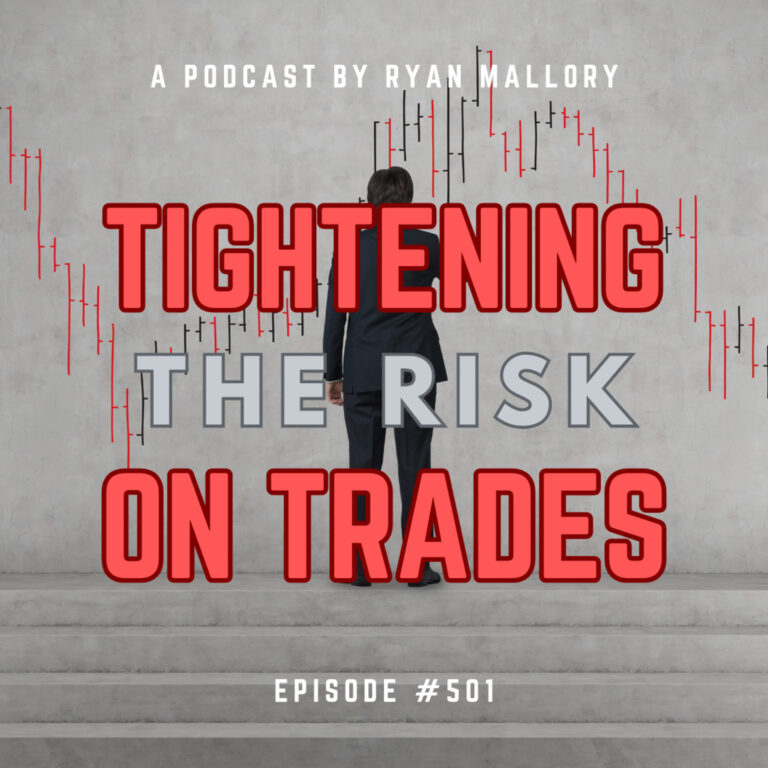Episode Overview
Can a stock form a bull flag following an earnings gap to the upside? And if so, can it or should it be traded? In this swing trading podcast episode, Ryan talks about the bull flag patterns and the things to know surrounding the pattern and earnings.
Available on: Apple Podcasts | Spotify | Amazon | YouTube
Episode Highlights & Timestamps
- [0:07] Introduction to the Podcast
Ryan opens with his mission to help traders thrive in today’s market and introduces the episode topic: bull flags and earnings. - [0:49] A Listener from Sweden Asks About Bull Flags
Jasper, a Swedish father of three, asks whether bull flags that form after an earnings gap-up are legitimate setups. - [2:18] What is a Bull Flag?
Ryan explains bull flags in simple terms, including their appearance, formation, and why they matter in trading. - [4:50] Do Bull Flags Work on Earnings?
Using Netflix as an example, Ryan discusses whether post-earnings flag formations hold up and what makes them different. - [8:09] Stop Loss Management Challenges
Ryan explains why managing stop losses on bull flags can be tricky and how patterns sloping lower often lead to premature exits.
Key Takeaways from This Episode:
- Not All Bull Flags Are Equal: Those forming naturally after a strong uptrend tend to be more reliable than ones forming from earnings gaps.
- Earnings Trump Technicals: Earnings often override technical patterns, making setups riskier and less predictable.
- Avoid the “Floating Flag” Trap: A bull flag without a proper “pole” is less convincing and more prone to failure.
- Stop Losses Require Strategy: Bull flags slope downward, which can lead to stop losses being hit even when the pattern remains valid.
- Discipline is Key: Adjusting stop losses after entering a trade is undisciplined and can lead to bigger losses.
Resources & Links Mentioned:
- Swing Trading the Stock Market – Daily market analysis, trade setups, and insights by Ryan Mallory.
- Join the SharePlanner Trading Block – Get real-time trade alerts and community support.

Take the Next Step:
✅ Stay Connected: Subscribe to Ryan’s newsletter to get free access to Ryan’s Swing Trading Resource Library, along with receiving actionable swing trading strategies and risk management tips delivered straight to your inbox.
📈 Level Up Your Trading: Ready for structured training? Enroll in Ryan’s Swing Trading Mastery Course, The Self-Made Trader, and get the complete trading course, from the foundational elements of trading to advanced setups and profitable strategies.
📲 Join the Trading Community: Sign up for SharePlanner’s Trading Block to become part of Ryan’s swing-trading community, which includes all of Ryan’s real-time swing trades and live market analysis.
Full Episode Transcript
Click here to read the full transcript
0:07
Hey, I’m Ryan Mallory and this is my Swing Trading the Stock Market podcast. I’m here to teach you how to trade in a complex, ever changing world of finance.
0:16
Learn what it means to trade profitably and consistently, managing risk, avoiding the pitfalls of trading, and most importantly, to let those winners run wild.
0:25
You can succeed at the stock market, and I’m ready to show you how. Hey everybody, this is Ryan Mallory with Swing Trading the Stock Market.
0:34
In today’s episode, we’re going to be talking about bull flags. Got a letter from a guy.
0:37
I guess it’s not a letter, It’s an e-mail. An e-mail from a fella that he lives in Sweden.
0:42
He’s Swedish, he’s a dad of three and has a question about bull flags, particularly as it pertains to earnings.
0:49
So we’re going to talk about bull flags. And for a good Florida redneck name, I’m going to give this guy the name of Jasper.
0:55
So Jasper writes hi of Swedish dad of three I have on and off engaged in the stock market mostly on global index funds.
1:03
Recently I have found an interest in swing trading and I started to listen to your great podcast to learn more.
1:08
So to my question, bull flags high and tight flags are obviously an interesting pattern to track, but would you consider a quick rise on earnings and then a flag formation the following days to be a real bull flag?
1:19
Of course the same would then apply to bear flags or must the flag form outside of earnings?
1:26
Best regards, Jasper, Good question, Jasper. And I don’t know if there is necessarily a right or wrong answer.
1:33
If you trade it off of an earnings report and you get a bull flag and it breaks to the upside, obviously it worked at that particular time.
1:40
Over the years, what have I found? I have found that the earnings bull flags and essentially what you got there is you have a stock…
1:46
That’s reporting earnings and it has a massive gap higher as as a result of earnings. And then the next few days or maybe it’s a couple of weeks, it starts to form some sideways…
1:55
Consolidation or a bull flag. Those tend to work not as good as a stock that just goes on like a one or two-month ripped to the…
2:04
Upside and then starts to bull flag. Those are the ones that I prefer the most.
2:09
Now what is a bull flag? Some of you guys might be listening to this and like Ryan, I don’t even know what the heck a bull…
2:14
Flag is. So kind of explain it to me like I’m a fifth grader or something.
2:18
So essentially what a bull flag is, if you don’t know a stock makes a good run to the upside. And of course, with bull flags, it’s best seen on a chart that uses candlesticks.
2:28
And I’m not gonna get into candlesticks on this one, but just just Google it if you’re not quite sure what that is.
2:33
But for a bull flag, stock makes a good run higher. Often times it’s a pretty steep run and then it starts to consolidate.
2:40
And by consolidation, I mean, like let’s say a stock makes a run over the course of, you know, a couple months from 100 to 120.
2:47
Instead of just coming right back down and giving up all those gains, it starts to consolidate in a type pattern.
2:51
Usually it’s in a slight slant downward, so there’s a little bit of profit taking, but there’s not extreme profit taking.
2:58
People weren’t just like, Oh my gosh, I’m getting out of this and and the masses are following. It’s more or less.
3:05
There’s an equal supply of buyers and sellers, maybe a slight edge to the sellers, but nonetheless what it ultimately looks like is a flagpole with a flag on it with a slight downward bent.
3:16
The flag being a slight downward bent. Now it doesn’t have to be parabolic.
3:19
It doesn’t have to be like straight up or 90° straight up. It can be at a 45° angle.
3:25
But the key part is that it consolidated most of the move and they can be really good, their continuation patterns, they can be really good at getting in.
3:33
After a stock has made that initial move to the upside, you missed out on it. And so now you see the bull flag and you want to get into the long side.
3:41
And So what? Essentially, and and this is what a lot of people don’t always think about, it’s always important to…
3:47
Ask yourself, what does that pattern mean? Yes, I know what the pattern is.
3:50
I know what a head and shoulders pattern is. But what does it actually mean?
3:53
Or it could be a cup and handle pattern, or it could be a continuation triangle. What do these patterns actually mean?
3:59
So in the case of bull flags, yeah, you have a little bit of profit taken out, some people cashing out, but there’s still an influx of buyers willing to support that price from giving up too much…
4:07
Ground. And so that’s a good sign when a stock’s not willing to give up much ground after making a big run.
4:12
Maybe it’s just a little bit and that’s where you get the bull flag pattern. And so it’s a good sign that it’s gonna continue to the upside once more buyers come in and the…
4:20
Sellers are done with their initial profit taking. So that’s what a bull flag mean.
4:24
Now if you’re trying to trade it on an earnings gap where instead of it going from like 100 to 120 over the course of a couple months, the stock is going from 100 to 120 overnight because it had a…
4:33
Really good earnings report. And then the next few days it starts to consolidate.
4:36
Well, we just had a great example of that just recently here in 2024. And I tell you the date just in case you’re listening to this five years from now, you’re like, oh…
4:44
What year is he talking about? It’s like, yeah, I’m talking about the Netflix earnings that took place in quarter one 2024.
4:50
So you had a huge beat. It gaps way to upside, but it doesn’t do much after that and it starts to consolidate and it formed…
4:58
A like a textbook bull flag, but without the pole. It didn’t really have that pole.
5:03
It just it’s like a flag floating out there in the air. It’s like it came detached from the pole and it’s just like floating in the sky, like the little…
5:10
Feather from Forrest Gump to the Forrest Gump music, right.
5:15
But now that’s essentially what Netflix did. It had a flag that’s just like floating out there on the chart and then it broke to the upside for a…
5:20
Couple days. It made a really nice move. There was some resistance overhead, which I thought might cause it some problems.
5:24
But no, it blew right through that resistance as well. So it it made a move of about two or three percent if I remember off hand correctly.
5:30
It wasn’t bad. And then it gave it all up because the market started to pull back some as well and some people…
5:34
Started doing some profit taking and technology and and communications at large. So that weighed on the stock as well.
5:41
But you had that bull flag pattern. So to Jasper’s question, does it work on earnings?
5:45
Yeah, in that case it did. On some of them, it may not.
5:47
I would say that the most reliable bull flag patterns are going to be where it you know it, it has a strong run and then it consolidates the move.
5:56
And it’s not something that happens from a earnings event because the the other thing about earnings too, it’s it’s not a respect or usually have technical analysis, it really doesn’t care.
6:04
So often times what you’ll see from earnings are massive moves that’ll blow right through support and resistance levels not even struggle to breakthrough them.
6:12
It’ll just blow right through because earnings events really Trump’s everything else in the market. And so when you get a big gap higher because of the earnings events, I’m not as likely to trust the…
6:22
Bull flag pattern. I don’t usually trade them.
6:24
I like to see the pole, not just a flag that’s just floating up in the sky somehow.
6:27
And also too, with an earnings gap, it’s usually going to be extremely overbought.
6:33
If it’s making a big move as a result of it creating that big gap, it’s gonna probably be extremely overbought.
6:39
And that’s not really something that I want either because with bull flags, what you’re usually getting there is a period where the market or the stock is working off those overbought conditions.
6:50
But the earnings gap, it can be so extreme that it can take a long time for it to pull flag. And when finally completes that pattern to the upside, it’s still overbought.
6:57
So that’s another reason why I’m not a huge fan of those, Mike.
7:03
Let’s take for instance, SMCIA.
7:03
Year ago it was trading at $83 a share. It went all the way up to 1100.
7:07
Now since it’s like pulled back like 3 or 400 bucks a share.
7:10
But with that being said, but I want to get into Smci after just over the last month alone it’s gone…
7:17
From like 300 to 1100 and let’s say instead of pulling back to the $700.00 range, it’s starting to consolidate around that 1100 range.
7:24
But I even consider trying to play something like that. Heck no, no, I would, I’d stand aside that’s that’s a little bit too much.
7:30
But it’s not that goes from like 100 to 120 or even like 100 to 110 and it starts to bull flag.
7:37
Are those usually good opportunities? Yeah.
7:37
Especially if the sector, the industry and the and the overall market is lining up with it.
7:42
Now let me tell you about a good place to find some of these bull flags. That’s with swingtradingthestockmarket.com, swingtradingthestockmarket.com.
7:48
That’s going to give you access to all of my stock market research each and every day from charts that I provide on individual stocks and watch lists and weekly updates of my bullish and bearish…
7:59
Stocks that I’m following. Plus it’s going to give you big tech updates and overall market updates.
8:04
Really cool value, really cheap. Worth checking out at swing trading, the-stockmarket.com.
8:09
But the thing that I usually run into the most problems with on bull flags is a stop loss managing risk.
8:13
Because bull flags do slope lower and as a result of them sloping lower slightly. Remember, we’re talking about a flag here.
8:20
Flags tend to slope a little bit, right?
8:20
It’s easy for you to get into the stock and if it doesn’t break out immediately, let’s say it just like goes a few cents above the breakout level and then pulls back and it stays within the pattern.
8:28
But it can pull back for enough time where it’s still in the pattern but it stops you out.
8:36
Because that stop loss eventually, even if you have it outside of the pattern initially when you got into it, if price pulls back into the pattern and it stays within that pattern for a little bit at a…
8:45
Time, that stop loss could find its way inside of that pattern, which is not ideal.
8:49
And I hate the idea of expanding my stop loss after I get into a trade.
8:53
That’s something that I consider to be a lack of discipline when one does that, and I’m certainly not gonna start that with full flag patterns either.
9:01
So that can be a frustrating aspect. One of the things when I get into trades, I like to place my stop loss at a level to where if the…
9:08
Trade doesn’t work, I want it to invalidate that pattern. If it’s a breakout of like a cup and handle pattern, I want it to invalidate the cup and handle.
9:15
If it’s a bull flag, I want it to invalidate the bull flag.
9:15
But the problem with bull flags is that when you get into the trade, and if it comes back down inside that range, it may not be invalidating the pattern when it stops you out because it’s sloping…
9:28
Slightly lower. And the same thing goes for bear flags.
9:28
I’ve been primarily focused on bull flags, but he also asks about bear flags.
9:32
Yeah, I would say bear flags on an earnings play. Probably something worth watching out for because I wouldn’t trust those at all.
9:39
And the reason being is that it could be forming a base as well. Sometimes those bear flags, they can quickly morph into a basing pattern.
9:47
And So what you think is a slight. And for those who don’t know what a bear flag is, let me just explain that.
9:51
It’s pretty easy. It’s the exact opposite of a bull flag, except essentially it’s like a flag on the bottom of a pole.
9:58
It’s like it never got raised up the flagpole. So bear flag’s on the bottom of the pole, so it’s a it’s a move to the downside and then it’s a…
10:04
Slight upward flag pattern. And like I said, the problem with those, if you’re gonna trade them, is that it can quickly turn…
10:11
Into a basing pattern. So that’s one thing to keep in mind with.
10:14
I think the stop losses on shorting of Bear Flag also applies. Those can be very difficult, but especially with our earnings place, I wouldn’t do that.
10:21
When stocks drop like 1520% as a result of earnings, it’s usually best to wait a while for…
10:30
Considering getting back into that trade or or considering a trade set up.
10:33
If I’m gonna get long on it, I want to see a nice long basing pattern to get short on it. Again, you’re probably shorting into extreme oversold conditions when there’s a significant sell…
10:38
Off. Best to do it when it’s steadily marching to the downside and that’s going to do it.
10:42
For this podcast episode, it was a pretty short one, but I felt like it was one that was worthy of being addressed.
10:48
I like questions like these. I like questions that you guys have continued to provide me for the years.
10:51
I’m approaching my 400th podcast episode, which I think is pretty awesome.
10:54
When I first set out to do this, I didn’t know I’d be doing 400 podcast episodes at some point.
10:59
But you guys have been spectacular with providing me with these questions and keep sending me your questions, Keep sending me your thoughts.
11:05
Tell me your stories because I want to hear them. Check out swingtradingthestockmarket.com and if you can, if you’ve enjoyed this podcast over the…
11:11
Years, leave me a five star review on whatever platform you’re listening to it on. That would mean the world to me.
11:16
Thank you guys and God bless. Thanks for listening to my podcast Swing Trading the Stock Market.
11:22
I’d like to encourage you to join me in the SharePlanner Trading block where I navigate the stock market each day with traders from around the world.
11:30
With your membership you will get a seven day trial and access to my trading room including alerts via text, e-mail and WhatsApp.
11:37
So go ahead, you sign up by going to shareplanner.com/trading Block, that’s www.shareplanner.com/trading and follow me on SharePlanners, Twitter, Instagram and Facebook…
11:49
Where I provide unique market and trading information every day. If you have any questions, please feel free to e-mail me at ryan@shareplanner.com.
11:57
All the best to you and I look forward to trading with you soon.
Enjoy this episode? Please leave a 5-star review and share your feedback! It helps others find the podcast and enables Ryan to produce more content that benefits the trading community.
Have a question or story to share? Email Ryan and your experience could be featured in an upcoming episode!
Become part of the Trading Block and get my trades, and learn how I manage them for consistent profits. With your subscription you will get my real-time trade setups via Discord and email, as well as become part of an incredibly helpful and knowledgeable community of traders to grow and learn with. If you’re not sure it is for you, don’t worry, because you get a Free 7-Day Trial. So Sign Up Today!

Welcome to Swing Trading the Stock Market Podcast!
I want you to become a better trader, and you know what? You absolutely can!
Commit these three rules to memory and to your trading:
#1: Manage the RISK ALWAYS!
#2: Keep the Losses Small
#3: Do #1 & #2 and the profits will take care of themselves.
That’s right, successful swing-trading is about managing the risk, and with Swing Trading the Stock Market podcast, I encourage you to email me (ryan@shareplanner.com) your questions, and there’s a good chance I’ll make a future podcast out of your stock market related question.
In today's episode, I talk about tightening the risk on the trades and the benefits of taking a multi-pronged approach in doing so between profit taking and raising the stops. Also, I cover how how aggressive one should be in adding new swing trading positions and how many open positions that one should have at any given time.
Be sure to check out my Swing-Trading offering through SharePlanner that goes hand-in-hand with my podcast, offering all of the research, charts and technical analysis on the stock market and individual stocks, not to mention my personal watch-lists, reviews and regular updates on the most popular stocks, including the all-important big tech stocks. Check it out now at: https://www.shareplanner.com/premium-plans
📈 START SWING-TRADING WITH ME! 📈
Click here to subscribe: https://shareplanner.com/tradingblock
— — — — — — — — —
💻 STOCK MARKET TRAINING COURSES 💻
Click here for all of my training courses: https://www.shareplanner.com/trading-academy
– The A-Z of the Self-Made Trader –https://www.shareplanner.com/the-a-z-of-the-self-made-trader
– The Winning Watch-List — https://www.shareplanner.com/winning-watchlist
– Patterns to Profits — https://www.shareplanner.com/patterns-to-profits
– Get 1-on-1 Coaching — https://www.shareplanner.com/coaching
— — — — — — — — —
❤️ SUBSCRIBE TO MY YOUTUBE CHANNEL 📺
Click here to subscribe: https://www.youtube.com/shareplanner?sub_confirmation=1
🎧 LISTEN TO MY PODCAST 🎵
Click here to listen to my podcast: https://open.spotify.com/show/5Nn7MhTB9HJSyQ0C6bMKXI
— — — — — — — — —
💰 FREE RESOURCES 💰
— — — — — — — — —
🛠 TOOLS OF THE TRADE 🛠
Software I use (TC2000): https://bit.ly/2HBdnBm
— — — — — — — — —
📱 FOLLOW SHAREPLANNER ON SOCIAL MEDIA 📱
*Disclaimer: Ryan Mallory is not a financial adviser and this podcast is for entertainment purposes only. Consult your financial adviser before making any decisions.





